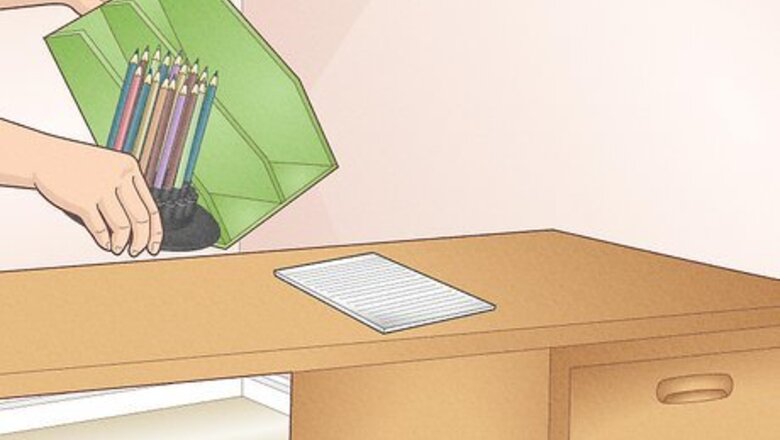
views
- Clean your desk by removing every item and placing it elsewhere. Wipe down all surfaces using a duster or disinfectant spray.
- Sort through your things and determine which are essential. Throw away, recycle, or donate any items you no longer need and put unnecessary stuff in storage.
- Organize everything you want to keep utilizing your desktop, drawers, and shelves. Add labels so you know where everything is.
Clearing and Cleaning Your Desk
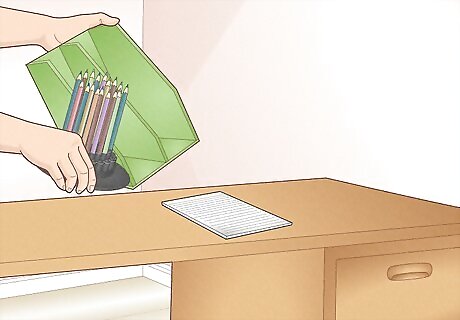
Remove all belongings and place them into one pile. Even if you know you'll put items back in the same place, take everything off. This includes pictures, plants, papers, diaries, your computer, etc. When it’s time to reorganize your desk, you’ll sort through this pile methodically.
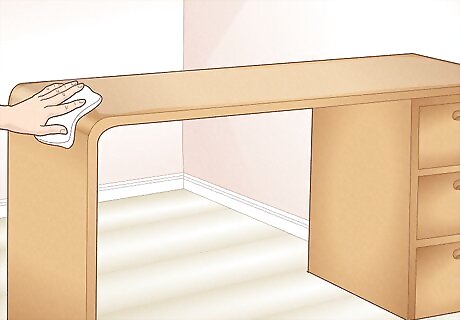
Wipe down all surfaces with a duster and cleaning spray. Whether commuting to work or working from home, all the surfaces you touch have bacteria, which transfer to your coffee mug, phone, and computer. Even if you think the things on your desk are pretty clean, giving everything a once-over doesn't hurt. Clean your computer screen using electronic wipes, dust all of the surfaces, dump out and wipe down desk drawers. Use compressed air to clean your keyboard or any other objects with difficult to reach areas. Create a water and white vinegar solution using 3 cups (710 mL) of water and 1 cup (240 mL) of vinegar to clean many surfaces or purchase a disinfectant spray of your choice. Surfaces include the top of your desk, the inside of your drawers, the tops of shelves, and any screens.
Sorting Your Stuff
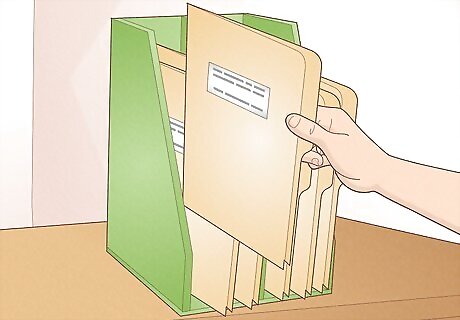
Go through your items one by one. Begin going through the pile from top to bottom. Don't skip over anything. Separate important things that will eventually go on shelves or in drawers. If a paper needs to be shredded or a knick-knack needs dusting, do it now. Don't wait until later. If it takes more than two minutes to deal with an object (for example, if the paper shredder is in another building or you'd need to buy a duster), place the object on your "to-do" list.
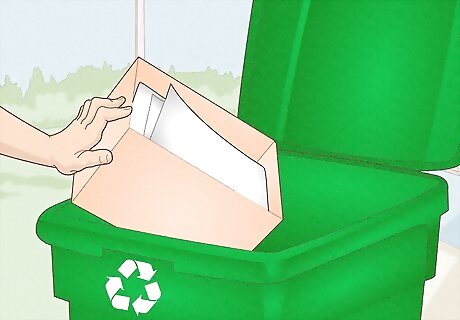
Throw away trash and place recyclable items in suitable containers. Something becomes trash when you haven't used it in two years; you bought something new to replace it, or, as expert organizer Marie Kondo says, when it no longer brings you joy. However, if you're unsure, place it into a designated area to revisit later. Shred any sensitive documents before disposing of them. Recycle paper, plastic, and anything else that is recyclable.
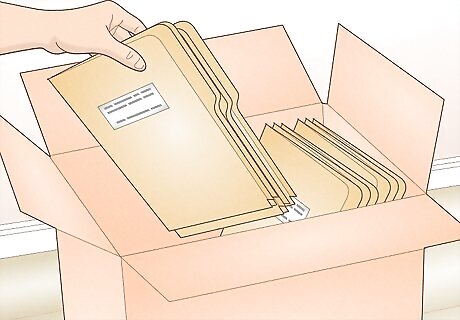
Store objects you're unsure about. Put the pile of objects that don't belong on your desk in a box or a drawer. Store that container in a basement or closet. Go through that container after a month, six months, or a year. If you have yet to use something from it, throw it away. The chances that you'll ever use it are very slim.
Organizing Your Desk
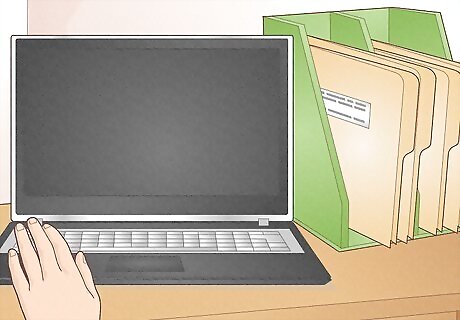
Organize things in a way that works for you. Everyone has a different way of organizing their desk and tools. Yours will depend on the kind of work you do at your desk. Whatever you do, keep the space usable and clear of distractions. A cluttered desk will negatively impact the way you work and focus. Ask other people who work in your field how they organize their desks. They might have valuable insights for you! Try different kinds of containers for different items or file folders or bulletin boards to keep yourself organized. If your old system wasn't working and you've kept everything in drawers, switch to shelves or hooks. If you have difficulty focusing on your computer screen, try placing everything else out of sight.
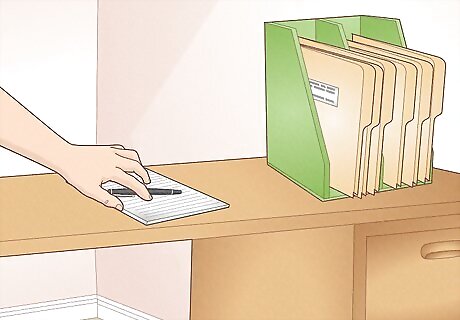
Replace objects on your desk. Return each object from the first pile one at a time. Follow the organization labels you've created or another organization system of your choice. Try to avoid having a lot of visual distractions at your desk. Limit the amount of decorations you have so you can still focus. Books are best kept off your desk if possible. Have an accessible shelf where you can keep the books you need regularly.
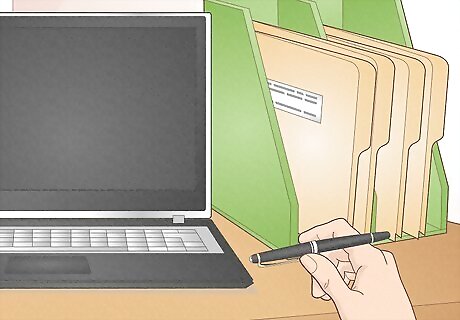
Keep only relevant tools nearby. If you mostly use your desk for office work, don't keep your craft supplies there. Choose a different place in your room or office to keep those things. If you notice certain items rarely or never get used, don't keep them at your desk. If there's a tool or resource you use a lot but have been keeping elsewhere, create a space for it at your desk. If you have a lot of tools, hang them on your wall.
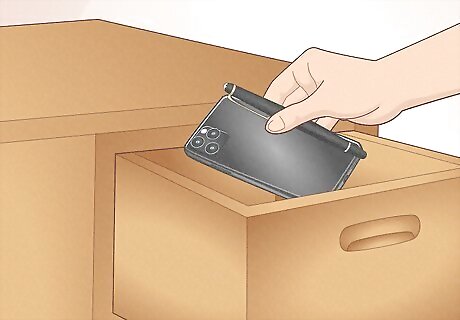
Make important tools and items accessible. You know the things that you use at your desk the most often. Keep those things close by and easy to get to. For example, an architect may want extra rulers, sketching tools, and X-acto knives easily accessible in a top drawer. You can choose a few important things that sit on your desk. These can include current projects or repeatedly used tools, such as a ruler or calculator.
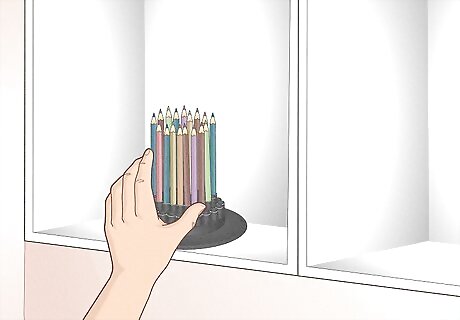
Use shelves. You may want to build shelves into the wall, buy them, or use shelves you already have. Place shelves above your desk or on the other side of the room if you put up shelves. If your desk is in a cubicle at work, you may need to set up a tabletop desk organizer. If your desk is in a home office or bedroom, you may want your shelves out of sight so they don't pose a visual distraction. Think about what will go on the shelves before you install them. Make sure they're the right size for the books or tools you plan to put on them.
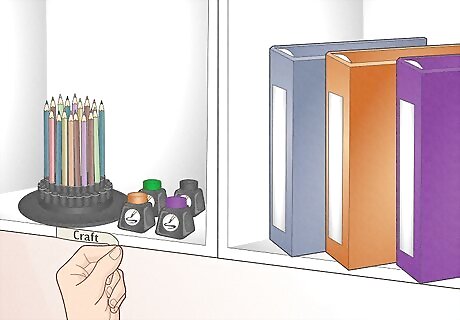
Label drawers and shelves without damaging them. By labeling shelves and drawers, you're telling yourself what goes in each place. You can make your own labels with masking tape or stickers, or you can buy more decorative labels if you prefer. Make sure each label is clear and specific. That way, no drawer will become a "junk drawer." You can use a color-coding system instead of writing words on each drawer. Be careful with labels. Refrain from generalizing too much; you may end up with messy drawers full of miscellaneous items.
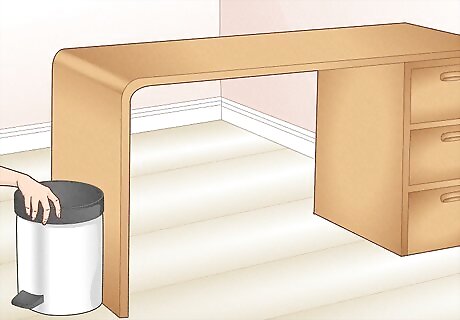
Place a trashcan underneath or on the side of your desk. Place a trashcan within reach to avoid throwing trash on your desk. Ideally, you want it close enough that you don't have to leave your desk. That way, there's no danger of junk creating clutter.
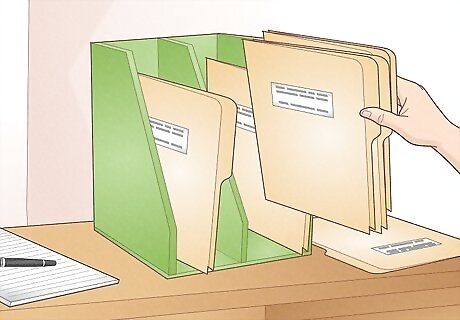
Clean your desk regularly. The more frequently you clean your desk, the easier it will be each time. Look at your desk and tidy it up at the end of each day. Throw away any trash and file away stray papers or pieces of a project. By cleaning your desk off at the end of each workday, you create a clean and usable work environment for the next day. Designate one day per week or month to deep clean your desk, depending on how quickly it gets messy or disorganized.















Comments
0 comment